What should we work on next and who’s going to do it? We recently created a new internal app called Iterations to answer that question. It’s for 1) managing our internal requests about which features/bugs to work on next and 2) helps us create teams/iterations to get them done (using our team-based way of working).
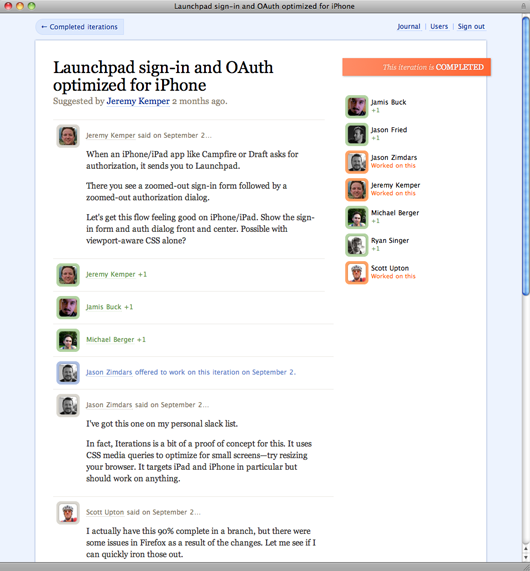 A completed feature request.
A completed feature request.
The problem
Before Iterations, we kept ideas for what to do next all over the place: in our heads, dumped into Backpack, on pet lists kept individually, in Campfire team rooms, etc.
Even when we did manage to collect ideas, the list(s) would quickly become unmanageable. Ideas ranged from tiny fixes to large-scale multi-term projects. It wasn’t clear who added each idea, and many were in the form of feature requests — not scoped to an iteration.
Collecting ideas
So we made Iterations in order to create an easy place to jot down a quick idea — even if it isn’t fully formed — and then let a team build on it from there. Iterations would also make it easier to expose small, slack-type projects that are ripe for doing when someone has a short window of downtime.
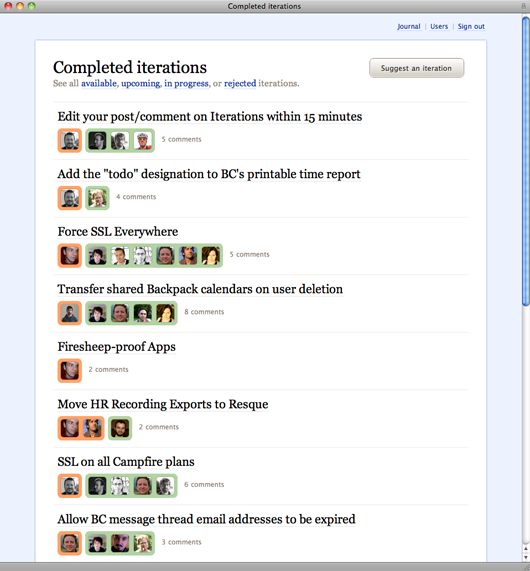 Viewing multiple requests at once. In this case, it’s completed items.
Viewing multiple requests at once. In this case, it’s completed items.
With v1 of Iterations, each member of our team can:
- Share an idea for something they’d like to be worked on
- Discuss ideas that have been posted
- Show support with a +1 for the ideas they like
- Indicate interest in working on an iteration
- See what other people are interested in working on
- Form iteration teams
- See what is currently being worked on and what is done
Iterations shows who proposed the idea, who supports the idea, and who is interested in working on it. There is space for discussion of details, implementations, and scope. Similarly, it shows which projects aren’t viable and which ideas can be dismissed.
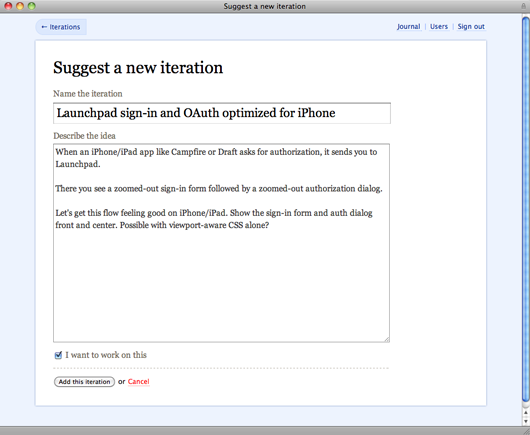 Suggesting a new iteration.
Suggesting a new iteration.
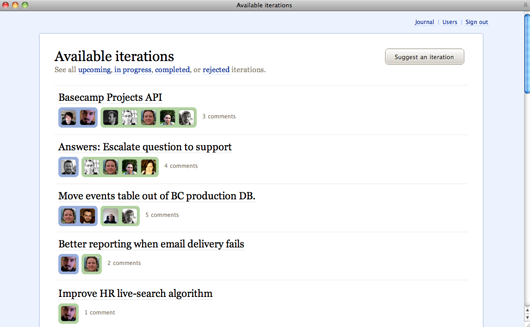
Avatars for each person who supports an idea shows the amount of interest in an iteration.
A new way of assembling teams
It also transforms the way we assemble teams. It lets people align themselves with the ideas they’re most excited to work on. The process of creating teams becomes more organic.
When a designer or programmer offers to work on something, they can see who else might want to work on that same iteration and form a team to do it. Similarly, a newly formed team might use Iterations at the start of a term to see which projects the members of the team have previously shown interest in and find common ground.
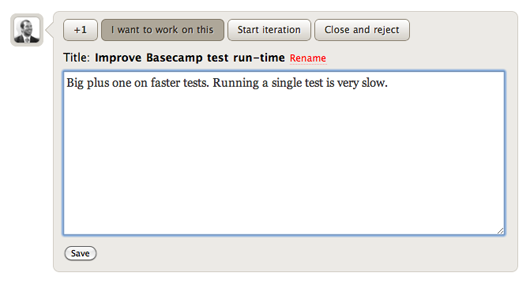 Finding common ground.
Finding common ground.
A working history
Iterations also keeps a history of proposed iterations. The stream of discussion as an idea forms and a team takes it on winds up being especially useful for 1) iterations that end but without launching anything or 2) when an exploration results in something we don’t want to further pursue.
From chalkboard to screen
The core of the app was designed in-person in a team room during our last company meetup. Here are a couple of chalkboard shots from those sessions:
Early modeling and UI discussion.
Our first sketch of the comment and actions UI. The heart button eventually became “+1”.
And an additional sketch after the meeting:
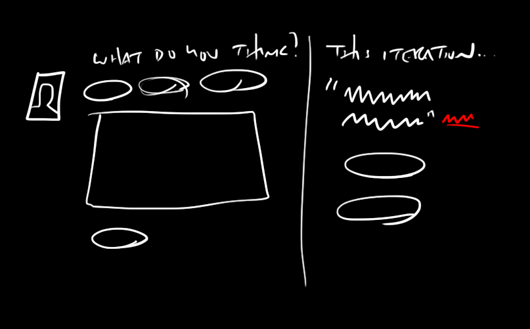 Further explorations of the comment UI.
Further explorations of the comment UI.
So far, so good
We built Iterations in about a week and have been using it since early September. So far it has been a great addition to the set of apps we use every day. Rarely does a day go by that someone hasn’t made a new suggestion or supported another. Right now Iterations shows 6 iterations in-progress, 15 completed, and dozens available for teams to pick up. We’ve even continued to tweak the app post-launch adding integration with our Backpack Journal and Campfire rooms.

Iterations integrates with Campfire.
Iterations helps us better understand what people are working on, what people want to work on, and what’s important. It’s turned disparate ad-hoc to-do lists into nicely scoped iterations that are ready to go.
(Will we be releasing this to the public? We’re busy focusing on other things right now. It’s unlikely we’ll put the work into polishing this up enough to be a product, but we can’t say for sure.)

Ryan Walker
on 12 Nov 10I was just commenting yesterday that I was looking for an app to help us prioritize internally what to do next with a project, giving user X votes… closest thing I could find is UserVoice has private forums. I would love to help make Iterations a commercial product if you’d be open to it, the competition in the space isn’t huge.
Joel Sutherland
on 12 Nov 10I like it!
How long did it take to develop? What was the time breakdown on different parts of the process?
Frankie Laguna
on 12 Nov 10This is absolutely amazing. I love seeing these “behind the scenes” looks.
I’m excited to see what comes of this, perhaps a new 37signals product?
Frankie Laguna
on 12 Nov 10Joel: From the article: “We built Iterations in about a week and have been using it since early September”
Alex Cook
on 12 Nov 10Really great. Love the behind the scenes photos… would love to use the beta if available.
Rocky Erwin
on 12 Nov 10Clever!
Sean McBride
on 12 Nov 10This looks really nice! Sort of like a mix between Tracker and Insightster. I’ve definitely felt the pain of too many tools to track existing work and ideas, so I’m excited about using something like this that can do both.
One thing that I thought when I saw this: it’d be nice to have a mechanism for keeping track of the big picture as well. What are the 2-5 big efforts that we’re pursuing right now, and which ones do each of our iterations move forward? Which big effort have we been neglecting? Which one are people most interested in?
Maybe efforts are a container for iterations?
Kevin Bongart
on 12 Nov 10This is a great idea and a beautiful tool! We use a list for ideas in Basecamp, but it’s quickly becoming unusable.
Jamey Stegmaier
on 12 Nov 10I was so excited about this until I got to the last paragraph and saw that it’s unlikely you’ll release this as a product. I’d sign up in a second, but for a different reason than the intended use. I don’t know if this would impact your decision for making a product out of this, but I’ll explain the other use just in case. Note that I’m only speaking for myself, but I bet countless other people who need to track ideas could use this.
I write fiction as a hobby. I get ideas for stories and characters all the time, and I make a note of them in-you’d better sit down for this-Outlook’s “notes”. I use that because it loads fast and I can sync it with my iPhone.
However, it has major shortcomings. You can’t search Notes. They have limited lengths. They’re not accessible on the web.
Also, I can’t easily rank my own ideas. For example, I might jot down an idea for a story and then return to it every now and then for the next few months (or even years). Sometimes I’ll stumble upon an idea and think, “Wow, that’s amazing.” Other times I’ll wonder, “What was I thinking?!” So I wish I could give a +1 to the best ideas-as Iterations does-so they rise to the surface over time and I can focus on them while I write.
I also want to be able to tag ideas for different genres or other characteristics. And I often want to add notes to an idea, expanding it over time.
From first glance, it looks like Iterations does all that. And perhaps this is just my creative process. But I’m guessing others would find it invaluable as well.
Joe
on 12 Nov 10This is great!
I was just talking to my boss about having a suggestion system for who wants to work on what. It’s wonderful to see this kind of thing in action out there elsewhere. I just may have to point him to this =)
Noah Hendrix
on 12 Nov 10What is the “Journal” link in the top right for?
Will Kievit
on 12 Nov 10This is a great idea. I really wish you would take the time to launch this, even if it was only another tab in basecamp. Currently we manage blog articles and ideas through basecamp to do lists. But it can be a bit cumbersome… this would be a great way to do that.
Maxim
on 12 Nov 10Great system!
You are great, as always ;)
Want to work in your team…
JZ
on 12 Nov 10@Noah – The Journal link is kind of a shortcut page. You can see and post updates to any of the iterations you’re currently working on. It has the added benefit of cross-posting that entry to the journal in our Backpack account.
Lee Graham
on 12 Nov 10You should include this for free with the 37signals Suite. =)
Clint
on 12 Nov 10I like the look of this tool and can see how it might work for some teams. Did you consider using any of the online services provided to speed agile development? Iterations is a loaded word in agile development: perhaps something else that emphasizes these are feature-sets would be preferable.
Joshua Pinter
on 12 Nov 10I saw a glimpse of this in your last post about how your new team system was working and what you learnt over the past few months. I kept thinking, “Oh, let me see more of that Iterations app.”
Our team could desperately use it! Question is, do I wait for you to polish and release it or do I roll my own?
Great idea and, as always, thanks for sharing.
David Tolsma
on 12 Nov 10A similar solution that allows an entire group add ideas, and vote them up. http://bettermeans.com
David Tolsma
on 12 Nov 10It would make sense that once the iteration is promoted it would go into a BaseCamp Task for a project.
Christopher G
on 12 Nov 10+1 to releasing. Unless your internal product isn’t good enough for the unwashed to send you $$ to access. Which I doubt.
Elomar Souza
on 12 Nov 10Given that it’s unlikely that you’ll put the work into polishing this up enough to be a product, any chance of open-sourcing it (maybe with some license that didn’t allow hosting your commercial version)?
Besides being useful, it would be really interesting to dive into the code of a 37signals Rails app :)
Mike Davis
on 12 Nov 10Really hoping this gets released even if it’s a host it yourself package.
Dave S
on 12 Nov 10This is a great incubation, participation and analysis concept! Really looks like it helps manage the idea development chaos, while keeping everything in a single location.
I’m curious how you pick/prioritize the ideas you choose to work on. Do you pick based on the largest interest of the team or some other priority?
JZ
on 12 Nov 10@Clint – We didn’t look for other tools. At it’s essence, this is a ticketing system but very much built for our one specific purpose. The name, Iterations, probably wouldn’t last as a commercial product but it perfectly fits our process.
@Christopher G – there’s definitely more to it than that. Releasing this as a product means polishing the UI, adding user management, billing, support, a marketing site, etc. We’d never have made this if we had to consider all those things at the start.
@Dave S – We don’t use any formula for prioritization. It’s helpful for us to see who supports and how well supported an idea is internally, but we don’t work on something just because it’s a popular idea. The real goal here is to come up with a list of viable projects for our teams to snatch-up. A well-defined, well-supported idea that both you and your teammates like is a good start.
Don Park
on 12 Nov 10Great idea. Add a stats page and title it “Office Warmap”. ;-)
JF
on 13 Nov 10@Dave S – to add to what JZ said, inputs come from all sorts of angles. Customer requests, internal ideas, frustration points, customer service interactions, etc. Eventually the top ideas filter into Iterations and then the crew gets to decide what ultimately makes it to production.
cesar
on 13 Nov 10Iterations will be an awesome addition to 37signals suite … or publish it to github.com/37signals
Jakob
on 13 Nov 10+1. you should add this app to your products
Alex Tabone
on 13 Nov 10Although other software similar to Iterations can be found off-the-shelf, this is another case of 37signals scratching its own itch and creating a potentially shippable by-product. BRILLIANT!
Lukas
on 13 Nov 10I really like your Iterations, because it closes the loop between idea and its execution. Especially the “I would work on this” feature.
Don’t you think about offering this product public?
Oliver
on 13 Nov 10+1 @cesar for “publish it to github”
Sean Everett
on 13 Nov 10I think everyone in this discussion board forgot about minimum viable products, ship fast/early, and even the dang title of the post: iterating.
All the talk about “many things must happen to release publicly” simply doesn’t align with the 37 signals mantra. We also forgot about a little thing called teaser marketing. Of course there going to release this.
It’s built, works, and has value for tech startups like them and for me. They’re simply testing the idea as simply as possible: through social media. Expect a release by the first of the year. I’ll buy and have already sent this post to my startup tram and others.
Ahh 37 signals, just following the ole protocol while marketing current products in use case form. Well payed, my friends.
Erick Pinell
on 13 Nov 10I would love to see this released to the public. As a business owner and manager I would love to have a simple, single tool that helps us see what’s going on.
Pretty please…. :)
Dave S
on 13 Nov 10@JF and @JZ. Thanks for your comments and feedback!
I work at a company that has a similar feedback loop which receives requests from all angles. We have created a similar backlog that we tag and roughly prioritize with the different operational/product folks. However, often we dont spend enough time maturing the requirements or gathering interest and end up working on what we intuitively think is needed to be done vs. developer/designer interest.
I really like the idea of organically gathering both requirements and interest in this manner to help both mature the concept and interest. I think this will naturally address a good portion of priority. The rest we can use our intuition on.
Thanks again for sharing!
EH
on 13 Nov 10Interesting, there was another “voteable project management” site posted to one of the HN-ilk last week. I’m starting to wonder what other aspects of democracy will be implemented as site ideas, feature additions, or entire businesses.
Ryan Curtis
on 13 Nov 10Interesting post! Looks pretty cool!
Chris Whamond
on 14 Nov 10Wow. Must be something in the air.
I started on a similar project last month: SlowHunch.com, an ideas-sharing and collaboration site. It’s open-source and free. I built it for myself.
It was inspired by Steven Johnson’s amazing talk on Ted.com. Shortly after I watched his talk, I posted this on my blog and went to work on the concept of tracking and connecting ideas – not just for software, but for any activity, such as writing.
I launched a few weeks ago. Steven Johnson graciously mentioned it in his blog and tweeted it out to everybody. We have a nice little community forming.
If you’re interested in an app like this, head over and give it a try. Feel free to chime in and make suggestions. I’ll be releasing the code on Github soon.
I’ve gotten so much from the Rails community, DHH, Jason and all the crew there – it’s my way of giving back. Maybe it’ll help somebody else.
Hugo Baraúna
on 14 Nov 10Nice. How are you integrating this with what you already do through Basecamp?
jon da ville
on 14 Nov 10Bah. You guys do a turd and everyone says how wonderful it is. I hope your emperors clothes moment comes soon.
Yours jealously..
pauline
on 14 Nov 10This is simple and streamlined. +1! Question- How do ideas get rejected? is there a -1, or do people just discuss and ultimately decide it’s a no go? Also-it would be really cool if you could expose completed iterations to your user community and let them discuss, vote, ask.. etc.
Terry
on 14 Nov 10This is a great idea. I’d like to see it as a product that we could all use. My head is full of ideas all the time. If I don’t record them, I lose them. But when I do record them, I can never find them again because I’ve forgotten when and where I recorded it. Release it to the public…
Terry
Anonymous Coward
on 15 Nov 10Does this not cannibalize useage of your other products a bit?
Jared Cosulich
on 15 Nov 10Since you guys are not planning on launching this as a commercial product just wanted to let you know about our product, Insightster.com – maybe you can send people our way if they want a similar tool that is available commercially.
We just launched it as well, with the same idea in mind. Create a place to store, discuss, rate, like, promote, and prioritize ideas (products, features, bugs, marketing, sales, where to have the christmas party, etc)
Paul Walsh
on 16 Nov 10Hey. iterationshq.com is still available ;)
Colin
on 16 Nov 10Tool porn. The only thing you guys enjoy more than using tools is building them. And the only thing you enjoy more than building them is blogging about them. Then I think profiting ranks at the top. I think email and calendar are overhead, but whatever works.
Julio Faerman
on 16 Nov 10+1, i would buy that :)
Michael
on 16 Nov 10Does the 37signals team use Basecamp for anything?
Jorge Luis
on 17 Nov 10I think Iterations is “social networks brought to ideas management” with a bit of collaborative/social filtering.
This discussion is closed.